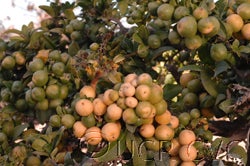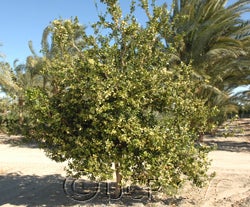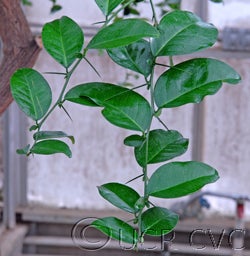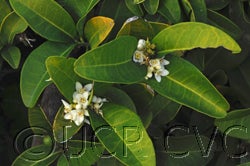Ceylon atalantia
CRC 3287
PI 539144
Source
Received as seed from John Carpenter, USDCS, Indio, CA, 1956.
Parentage/origins
Parents unknown
Rootstocks of accession
Cleopatra mandarin
Season of ripeness at Riverside
Year-round
Season of flowering at Riverside
April to October
Notes and observations
J. Carpenter received seeds from Orlando, Fla. PI #98732. "Yakinaran". Open-pollinated.
EMN, 2/1988: Dr. Bitters questions the identity of this accession. TCI (bottom left column of pp 317) indicates that A. ceylanica and A. zeylanica may be the same. But our accession (this and CRC 3725) are different. What do we have?
EMN, 1/23/1989: Several small purple fruits found- similar to fruits of CRC 1430.
Description from The Citrus Industry Vol. 1 (1967)
"This species was described as it occurs in Ceylon by Trimen (1893, p. 227) as follows: "A much-branched bush, usually armed with very sharp, stout spines, 1/4-1 in. [6-25 mm] long, bark smooth, brown, young parts glabrous, l[eaves] very variable, 1 1/4-3 in. [3-7.6 cm long], lanceolate or oval-oblong or somewhat ovate, rounded at base, emarginate or 2-lobed at apex, entire, coriaceous, veiny, petiole short, thick, glabrous; fl[owers] 1/2 in. [13 mm diam.] or rather more, on somewhat slender, glabrous ped[icels], usually crowded in short, very finely pubescent, corymbose, or racemose cymes much shorter than the l[eaves], bracts minute; cal[yx] lobes broad, shallow, often obscure, finely ciliate; pet[als] 4 (rarely 3 or 5), oval, with a broad claw, obtuse, thick, slightly concave, glandular; stam[ens] 8, alternate ones longer, quite distinct, fil[aments] flat, rather wider than anth[ers], anth[ers] cordate-ovate, apiculate; ov[ary] sessile, smooth, 2-celled, with 2 collateral ovules in each cell; style short, stout, stigma clavate; berry 1/2-3/4 in. [13-19 mm diam.], globular-ovoid, 2-4-seeded."
Hooker (1875, p. 511) described it as follows: "leaflet obtuse, notched or 2-lobed, rarely obtusely acuminate, flowers very shortly racemed, calyx 4-lobed, filaments free or 2 or 3 of them more or less combined, ovary 2-celled, ovules 2-collateral." He mentioned in the notes that the ovary is "sunk in the annular disk."
Atalantia ceylanica is remarkable for its nearly dry fruits, with the very few pulp-vesicles almost crowded out by the large, plump seeds that almost completely fill the locules. Small stipuloid paraphylls, 4 to 6 mm long, often occur singly or in pairs at the base of the petiole. This species seems to be related to A. guillaumini, from Indo-China, which apparently has lost its pulp-vesicles and has still larger seeds that completely fill the locules of the fruit."
Availability
Not commercially available in California.
USDA Germplasm Resources Information Network page for Atalantia ceylancia



